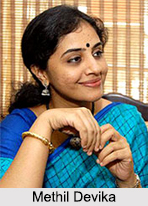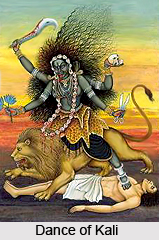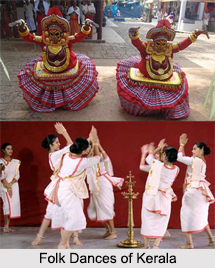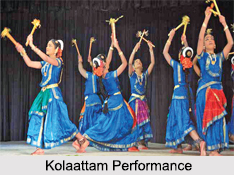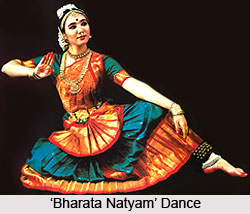 Forms of Indian classical dances are numerous, and were classified by the Hindu masters as of two kinds, `Margi` and `Desi`. The artistic composition of movement and its classification into various types of action is carefully described in the `Natyashastra` of Bharata Muni. There are three main components elucidated in this ancient treatise. The first one is `Natya` or actions that belong to the drama. Expressive movements of the body which are accompanied by facial expression and governed by rules of rhythm are called `Nritya` or dancing. Nritta refers simply to movements of the limbs, and does not involve facial expression. Dancing is again divided into two kinds known as `Tandava` and `Lasya`. The Tandava dance is characterized by intense excitement, the heroic mood (Vir) and the touch of wrath. It also expresses cosmic activity, the divine conquest of evil or the attainment of bliss. It is performed by both sexes. Tandava dancing joined to vocal music often forms a prelude to a certain type of dramatic presentation. Lasya dancing includes amorous expression and graceful movement of the limbs. It is danced by women and their consorts. The `Ras Leela` of Lord Krishna with the `Gopis` of Vrindavan is of the Lasya kind. `Laghu` dancing is performed by raising the heels slightly and alternately beating them on the floor.
Forms of Indian classical dances are numerous, and were classified by the Hindu masters as of two kinds, `Margi` and `Desi`. The artistic composition of movement and its classification into various types of action is carefully described in the `Natyashastra` of Bharata Muni. There are three main components elucidated in this ancient treatise. The first one is `Natya` or actions that belong to the drama. Expressive movements of the body which are accompanied by facial expression and governed by rules of rhythm are called `Nritya` or dancing. Nritta refers simply to movements of the limbs, and does not involve facial expression. Dancing is again divided into two kinds known as `Tandava` and `Lasya`. The Tandava dance is characterized by intense excitement, the heroic mood (Vir) and the touch of wrath. It also expresses cosmic activity, the divine conquest of evil or the attainment of bliss. It is performed by both sexes. Tandava dancing joined to vocal music often forms a prelude to a certain type of dramatic presentation. Lasya dancing includes amorous expression and graceful movement of the limbs. It is danced by women and their consorts. The `Ras Leela` of Lord Krishna with the `Gopis` of Vrindavan is of the Lasya kind. `Laghu` dancing is performed by raising the heels slightly and alternately beating them on the floor.
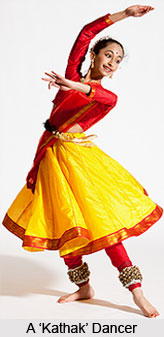 The most popular forms of classical dances practised in India involve Manipuri Dance, Bharata Natyam Dance, Odissi and several others, being widely prevalent in their patron states.
The most popular forms of classical dances practised in India involve Manipuri Dance, Bharata Natyam Dance, Odissi and several others, being widely prevalent in their patron states.
Bharata Natyam Classical Dance
Bharata Natyam is a well acclaimed classical dance which is the 19th and 20th century modifications of the dance-form called `Sadir` practised by `Devadasis` or temple dancers. It is quite popular and widely patronised in Tamil Nadu, particularly appreciated for its tender elegance, sculptural `mudras` and poses, and also its natural grace. Lord Shiva is believed to be the God of Bharata Natyam.
Chhau Classical Dance
The Indian tribal dance-form of Chhau is performed mainly in West Bengal, Jharkhand and Odisha and resembles martial arts to some extent. `Purulia Chhau`, `Seraikella Chhau` and `Mayurbhanj Chhau` are the various dances, classified according to its area of origin. Modern dance scholars are of the view that the term Chhau is a derivation of the Sanskrit term `Chaya` implying mask or shadow.
Kathak Classical Dance
Kathak is one the most famous classical dances which is influenced by temple dances, the `Bhakti Movement`, central Asian dance and Persian dances which were often displayed in the Mughal courts. The nomadic storytellers who were known as `Kathakars` are the ancestors of this dance form while Kathak is obtained from Sanskrit term `katha` implying `story`. It belongs to the `gharana` of Varanasi, Jaipur and Lucknow, which can be traced to the courts of Nawab of Awadh, Kachwaha Rajput rulers, etc.
Kathakali Classical Dance
The major highlights of Kathakali Dance include attractive attires, loud make-up of the performers, detailed body movements well coordinated with rhythm and time. It was founded in 17th century in Kerala and there has been certain additions and redefined gestures which have been added to this dance form, presently. This has enhances the beauty and aesthetic value of Kathakali.
Kuchipudi Classical Dance
Kuchipudi Dance originated in the 17th century in the state of Andhra Pradesh and Carnatic music is employed to accompany the dance-form, through instruments including `tambura`, flute, violin and the `mridangam`. The jewelleries worn by Kuchipudi dancers are generally lightweight and called `Boorugu`.
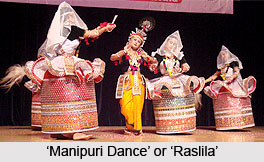
Manipuri Classical Dance
Yet another significant Indian classical dance is the Manipuri Dance which was born in Manipur in north-eastern India. This dance-form applies the major cult of Lord Krishna and Radha known as `Raslila` as its main theme. To improve visual appeal, `manjira` or `kartals`, double-headed drum or Manipuri mridanga are played while the dance is staged. Spiritual enjoyment is the aim of this dance.
Mohiniyattam Classical Dance
The Mohiniyattam dance form originated in Kerala during the 16th century and must be practised as `solo recitals` by the womenfolk, incorporating sensuous and graceful dance steps. It became very popular in 19th century thanks to the Maharaja of Travancore State named Swathi Thirunal as well as Vadivelu. Mohiniyattam is obtained from the terms `Mohini` implying a lady and `attam` meaning elegant body movements.
Odissi Classical Dance
The dance form of Odissi is also popular as `Orissi` and it belongs to Odisha, being considered the most ancient Indian classical dance, suggested by archaeological testimonies. Different `bhangas` or stances are the main parts of this dance and they include making various postures as one will observe in Indian sculptures.
Sattriya Classical Dance
Sattriya Dance is said to have been introduced by Srimanta Sankardev, a renowned saint during the 15th century in the state of Assam.
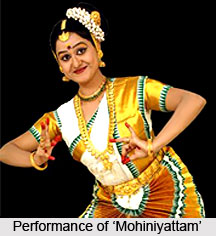 This dance was designed to accompany one-act plays known as `Ankia Naat` which were also created by Sattriya Dance.
This dance was designed to accompany one-act plays known as `Ankia Naat` which were also created by Sattriya Dance.
The humorous element has its legitimate place in Hindu drama and dance. The `Vidushaka` is the Hindu buffoon, and it is said to be the ancient prototype of the buffoon of medieval European drama. `Bhringi`, the skeleton attendant who accompanies Shiva in certain dance-modes, performs a grotesque travesty dance in imitation of his Lord`s rhythmic movements. In Java, where the great Hindu epic, the Mahabharata, is performed as a dance-drama, the hero Arjuna is always accompanied by three clowns who represent the powers of good that assist him in conquering his enemies.
With time different types of Indian classical dances evolved, namely, Bharatnatyam, Odissi, Manipuri, Kathak, Kathakali, Mohiniattam, etc. however the essence of these dances are integrally related to the ancient forms of Indian dances. However, a number of elements discussed in Natyashastra that were related to Natya are also still found in contemporary dance performances.
